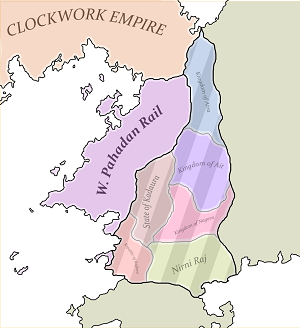West Pahadan Rail
The West Pahadan Railway Company & The Automata Arms Corporation | |||||||||||
|---|---|---|---|---|---|---|---|---|---|---|---|
| c.1906 - 1951 | |||||||||||
|
Flag | |||||||||||
| Motto: 'Crown, Company, Commerce' | |||||||||||
| Anthem: Anthem of the Clockwork Empire | |||||||||||
 WPR (purple), its vassals (striped) and the Clockwork Empire (orange) | |||||||||||
| Capital and largest city | Nakashigawa | ||||||||||
| Official languages | Onghiri, Pahadan | ||||||||||
| Ethnic groups | Xian, Shihoki, Taebong, Zhuyeian, Sangam and Rukhanan | ||||||||||
| Demonym(s) | Korrukan | ||||||||||
| Government | Colonial Stratocratic Corporatocracy | ||||||||||
• CEO | Zhang Xieren | ||||||||||
• Chairman | Liang Yating | ||||||||||
| Legislature | Regional Unity Committee | ||||||||||
| Colonial Corporation | |||||||||||
| 1906 - 1910 | |||||||||||
| 1910 | |||||||||||
| 1912 | |||||||||||
| 1912 - 1921 | |||||||||||
| Population | |||||||||||
• 1918 estimate | 38,912,331 (within WPR) 84,074,512 (within its vassals) | ||||||||||
• 1920 census | 122,986,843 | ||||||||||
| Currency | leyi (¤; LY) (LY) | ||||||||||
| Time zone | IMT +3 | ||||||||||
| Date format | yyyy.dd.mm | ||||||||||
| Driving side | right | ||||||||||
| |||||||||||
The West Pahadan Rail Company, officially called The West Pahadan Railway Company and Automata Arms Corporation and often referred to by the initialism of WPR, was a colonial corporate and military holding of the Clockwork Empire in Western Pahada. Spanning from the steppes of Tungnir to the tropical forests of central Pahada, the colonial holding was regarded as 'the most powerful company in the world', as it played an integral role in every aspect of civilian life within it.
It was formed on the onset of Clockwork's Second Initiative in an attempt to better accommodate Korrukan investment in the region, predominantly railways and telecommunication lines. Early into its operation it became a conglomeration with 'Automata Arms', an Imperial arms manufacturer that had defaulted on its debts.
Whilst its original and primary function was the operation of the railways and telecommunications, WPR soon came to dominate every aspect of civilian, military and economic life within its territories once noted military officer and Grand Commandant Zhang Xieren became CEO in 1912. During this period it underwent aggressive industrialisation of the Pahadan coast, forced reallocation of ethnic groups, ethnic colonisation and would go on to conquer numerous Pahadan states that would become its vassals.
WPR was noted for its own highly trained security force, its permitted status to control Imperial armies in the region, its aggressive campaign for Korukkan nationalism with its influence back at home and its disregard for international treaties against the Empire, which culminated in the company producing and operating its own maritime fleet.
Etymology
History
Geography
Location
Climate
Environment
Politics
Government
Foreign Relations
Military
Administrative Divisions
Demographics
Ethnic Groups
Largest Cities
Languages
Religion
Migration
Healthcare
Education
Economy
Under WPR, the economic power of Asphotachal grew exponentially over its almost fifty year existence. At its height in the late 1930s, Asphotachal accounted for roughly 1/7 of the entirety of the revenue received in the Clockwork Empire. The economic policies of mass industrialisation, more often than not at detrimental costs to the native population, saw an explosion of collectivisation, mechanised agriculture, numerous industrial revolutions, the expanse of mining and the promotion of arms manufacturing and domestic ship-building. WPR utilised Clockwork's close relationship with Drachenstaat to bring in numerous economic theorists to better educate the empire's existing administrators, including the famed Wechsler -- who oversaw numerous of his policies initially implemented in the region before taking them back home with him.
Agriculture
Whilst Asphotachal had nominally been agriculturally self-sufficient, the food surpluses envisioned by the Five Star Committee and the broader parts of 'SECOND Initiative' aimed on turning the fertile coasts of the region into a global bread-basket.
Land, originally held by the land-owning castes of the numerous merchant city states and oligarchs was collectivised and placed under the direct control of the company and the military. Small farmers were encouraged to 'voluntarily' give up their land in exchange for double its worth at the time, a policy that proved economically lucrative following the soy-bean explosion.
However, numerous attempts to cultivate the globally popular wheat failed. It was in fact a misunderstanding that began WPR's dominance of the soon-to-be immensely lucrative global trade in soya. WPR's production of soy was so immense, that by the early 1920s it accounted for over 85% of global production.
The mechanisation of agriculture saw the introduction of numerous automatons that slowly replaced the native Pahadans, increasing their persecution as they were now considered 'obsolete.' A journalist at the time reported that in Asphotachal's huge farming complexes, one could 'not see a single soul, for the soil was under the control of the machines.'
Other crops produced by WPR included rice, potatoes, carrots and onions for domestic consumption and coffee, cacao, tea and sugar for export.

